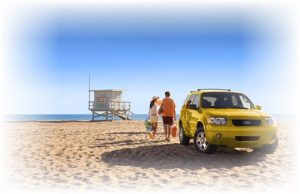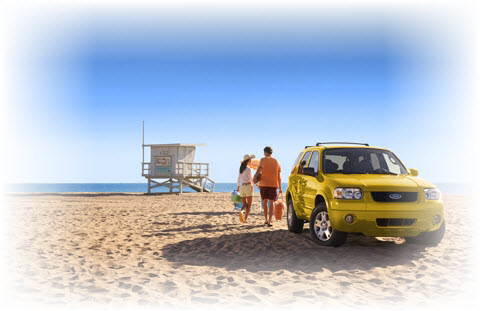 Renting a car in Uruguay is a tremendous way to get around if you intend to see many places in a short amount of time.
Renting a car in Uruguay is a tremendous way to get around if you intend to see many places in a short amount of time.
If you are simply going to one place (like Punta Del Este) for several days, it is better to travel by bus.
Bus travel is the most common way to get around for Uruguayans and, unlike most of the people, the buses are extremely prompt, leaving the station at the exact moment that it says on the itinerary.
And so, as my Uruguayan friend Vicky and I decided to tour the beaches, she recommended renting a car since we would be going to several beaches in a short amount of time. (NOTE: If you are going to be renting a car, be sure to learn some Spanish first. I used this Spanish program. You can download it now and begin immediately.)
This seemed like a good idea. However, after having lived in Montevideo for several months, I had seen many unconventional driving behaviors:
- In many places, there are not really marked lanes. The cars just take what room is available. I have been in several taxis and, when it appeared that there was no room for a car to fit, the taxi driver took it as a personal challenge: I can do it…you could see the look in his eyes.
- Having lived in downtown San Francisco for many years, I would often hear the pre-crash skids, but infrequently heard a crash. Here, I have heard, and seen, many crashes.
- Walkers are invisible. In California, you must always stop for a pedestrian. Here, it’s more like New York…a walker is a foreign object that is not meant to be in the street and so you are allowed to drive right over it as if it didn’t exist.
- Streetlights are kept to a minimum. On all streets except the main ones, intersections do not have street lights. Cars in one direction don’t need to stop. Cars going the other direction have a proceed with caution sign. I think “With Caution” is a phrase that was not introduced in the driving test and not understood by most. Most just proceed. This is where many of the aforementioned accidents occurred.
I later learned that many of these unconventional driving behaviors are only relevant in Montevideo. Once you are outside the city and on the main highways, driving is much like it is in the states. However, you will notice that the aggressive driving strain exists wherever you go.
We rented our car in downtown Montevideo at a place called Multicar. All of the people there were extremely friendly though I was glad to have my Uruguayan friend with me as nobody spoke English. I also wanted to make sure that we had car insurance just in case I made an unpleasant acquaintance of someone who elected to proceed.
Insurance is called “seguro” in Spanish, which is the same word for “I am sure”. And, yes, after having seen the driving in Montevideo, yes, seguro-por favor!
I acquired the insurance but the process is a strange one. Usually, in the states, the price of insurance is added to the bill and it’s usually an extra $10 or $15. However, here, they created a credit card slip for $100 (which seemed steep), but did not seem to charge my card.
I asked, “Am I paying this $100?”
He responded, “Oh, no, your card will only be charged if there is an accident.”
Of course, this was all in Spanish so I wanted to get the exact translation from my friend. And, yes, she said, that is correct. So, if nothing happens, I don’t need to pay? And if something happens, they simply charge my card $100?
Hmmm…curious? I wish all insurance worked like this. If nothing happens, I don’t need to pay anything? This is great. I wish it worked like this in the states. I would return to my health care provider and my car insurance provider and say: “Nothing has happened to me in the last 20 years, can you please give me back the $100,000 I have paid you over the years!”
(This was exactly how the insurance worked in my situation. I have difficultly believing this is common. If others out there have a different experience, please comment below.)
Then we get in the car, a nice little 4 door ford, and I realize that it is a manual transmission. Huh? I have never rented a car and gotten a manual transmission. I had that WTF look and my friend said to me: “What’s wrong?”
“It’s a manual,” I said.
She responded: “well, what else would it be?”
“An automatic?” I ventured with an inquisitive look.
“Oh, yeah,” she said, “we don’t have those here. I’ve never been in one and I wouldn’t know how to drive one.”
Obviously, I found this last line rather humorous. It’s like a calculus professor who can’t do addition and subtraction.
“Of course you could drive one. It’s much easier. You don’t have to use your left foot or your right hand.”
“Well,” she said, “we just don’t have those. Let’s go.”
She drove us out of Montevideo and, and in true Uruguayan fashion, proceeded with no regard for caution. I covered my eyes and prayed for that moment when we exited Montevideo. I took over once we hit the countryside.
Driving outside of Montevideo is very pleasant-there is only one safety note. Most highways outside of Montevideo are one lane in each direction. Thus, you play the passing game when you are stuck behind a slow moving vehicle.
On the way back to Montevideo, we were stuck behind a large truck, going uphill. The lines on the road indicated no pass. Vicky decided to pass anyway and I covered my eyes. I immediately heard her say “oh, shit!” as a car raced over the hill coming at us head-on.
Luckily, we slipped back into our lane just before the impending head-on collision, which would have cost the rental car agency well in excess of my $100 insurance payment.
Other Notes and Recommendations on Renting a Car and Driving in Uruguay:
- Uruguay is safe for a large South American city, but people do frequently break into cars. Keep all of your belongings, and especially the car stereo, with you and not in the car.
- Renting a car is reasonably priced (about $100 for 4 days) but a little more expensive in the peak of summer.
- If you are traveling with 4 or more people, you may want to rent a car as the price then begins to compare favorably with the buses.
- Driving in Uruguay is safe and the roads are nice. Just be careful driving in Montevideo-it’s like driving in many big cities in the states-people drive fast and aggressively.
- People drive fast and there don’t seem to be many police on the roads giving tickets.
- Don’t drink and drive…though here they do not have sobriety tests or stops. If you have an accident, they will then test you to make sure that your not drunk.
- Know where you are going. For example, on this trip, we were going to Cabo Polonio for our first stop which we assumed would be easily visible. It wasn’t. If you blinked, you missed it. So, don’t be afraid to ask people (they all know) and you need to have a general idea of how far you need to go (in kilometers). Otherwise, you might drive an hour past your intended destination.
- Car imports are taxed heavily in Uruguay. Thus, you don’t see as many new cars as elsewhere and people tend to keep their cars as long as possible. They say that Uruguay has some of the best mechanics around…to keep many of the old cars humming. None of this applies if you are in Punta Del Este, where you will find the best makes and models in all the world!
Richard Cummings
Get your copy of his latest book entitled Obvious Conclusions, stories of a Midwestern emigrant influenced and corrupted by many years living in San Francisco and abroad. It just received its first outstanding review "...reminiscent of David Sedaris or Augusten Burroughs" on Amazon UK.
Latest posts by Richard Cummings (see all)
- The Google Pixel Fold: Why It’s the Star of Google I/O 2023 - May 9, 2023
- Book Review:Malibu Rising by Taylor Jenkins Reid - March 6, 2022
- Beautiful World, Where Are You: A Book Review by Richard Cummings - February 18, 2022


Comments 1
Hello, Richard.
Thank you for your words about Multicar Rent-A-Car. We’ve improved quiet a bit since your last visit: we now offer the biggest network of car rental agencies in Uruguay, and the largest fleet (with many automatic cars available).
We would welcome a follow-up on your story whenever you come back to Uruguay.
Cheers.
Alfonso